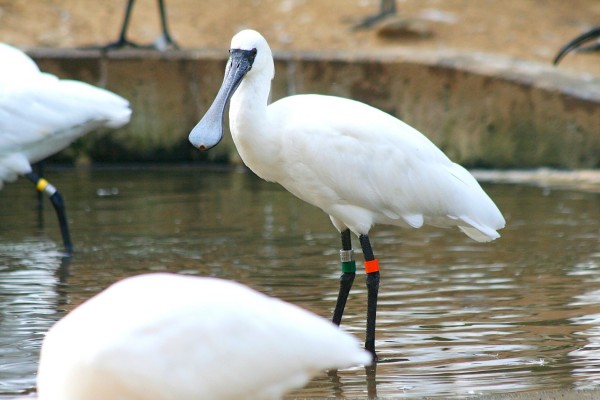《TAIPEI TIMES 焦點》 Human activity blamed for dwindling spoonbills in Tainan

Black-faced spoonbills wade in a pond at Taipei Zoo in an undated photo. Photo: Provided by Taipei Zoo.
By Chen Wei-han / Staff reporter
Researchers have discovered that human disturbance is behind the diminishing population of black-faced spoonbills and declining habitat conditions in the threatened species’ major habitats in Tainan, despite a recorded increase in the birds’ local and global population.
Listed on the International Union for Conservation of Nature’s red list of threatened species, the black-faced spoonbill is an endangered species, both domestically and internationally.
The bird’s global population hit a record high this year at 3,259 birds, up nearly 20 percent from the number last year, while a total of 2,034 birds were spotted in Taiwan this year, compared with 1,659 in January last year, according to the Chinese Wild Bird Federation.
However, the number of birds recorded in Zengwen River (曾文溪) and Sihcao Wetlands (四草溼地) in Tainan — traditionally the birds’ major winter habitat — have decreased and the population has spread to surrounding wetlands, which researchers said suggests a decline in habitat conditions due to an increase in human activity.
A research team, consisting of the Council of Agriculture’s Endemic Species Research Institute and the National Chung Hsing University said on Wednesday that it analyzed the number of overwintering years, maximum number of spoonbills, size of hospitable area and a land development intensity index to calculate the habitat value and connectivity of 23 selected wetlands to understand why the birds spread to other locations.
Institute researcher Chen Tien-shui (陳添水) said that development surrounding Tsengwen and Sihcao, especially the expansion of a local fish farming industry that has replaced seasonal, shallow ponds with permanent deeper pools, has reduced the food supply and forced the spoonbills to move to wetlands in Putai (布袋) and Beimen (北門) townships and Kaohsiung City’s Cieding wetlands (茄萣溼地).
“The spoonbill population in those areas has reached more than 100, making them important habitats that require conservation,” Chen said.
Higher habitat connectivity could ensure higher contact between different bird populations and the survival of the species. Large gap areas exist on the Changhua and Yunlin County coasts, where local spoonbill populations were once extinct, he said.
Heightened conservation of wetlands in central Taiwan to reconnect the ecological corridor in western coasts would help preserve spoonbill populations and increase biodiversity, he said.
The research results could be applied to other species and serves as a baseline for habitat linkage, corridor planning, and refuge design, he said.
The full research, titled A framework on Habitat Connectivity among Taiwan’s Wetlands for Overwintering Black-faced Spoonbill, is to be published in the journal Ocean and Coastal Management.
新聞來源:TAIPEI TIMES




















